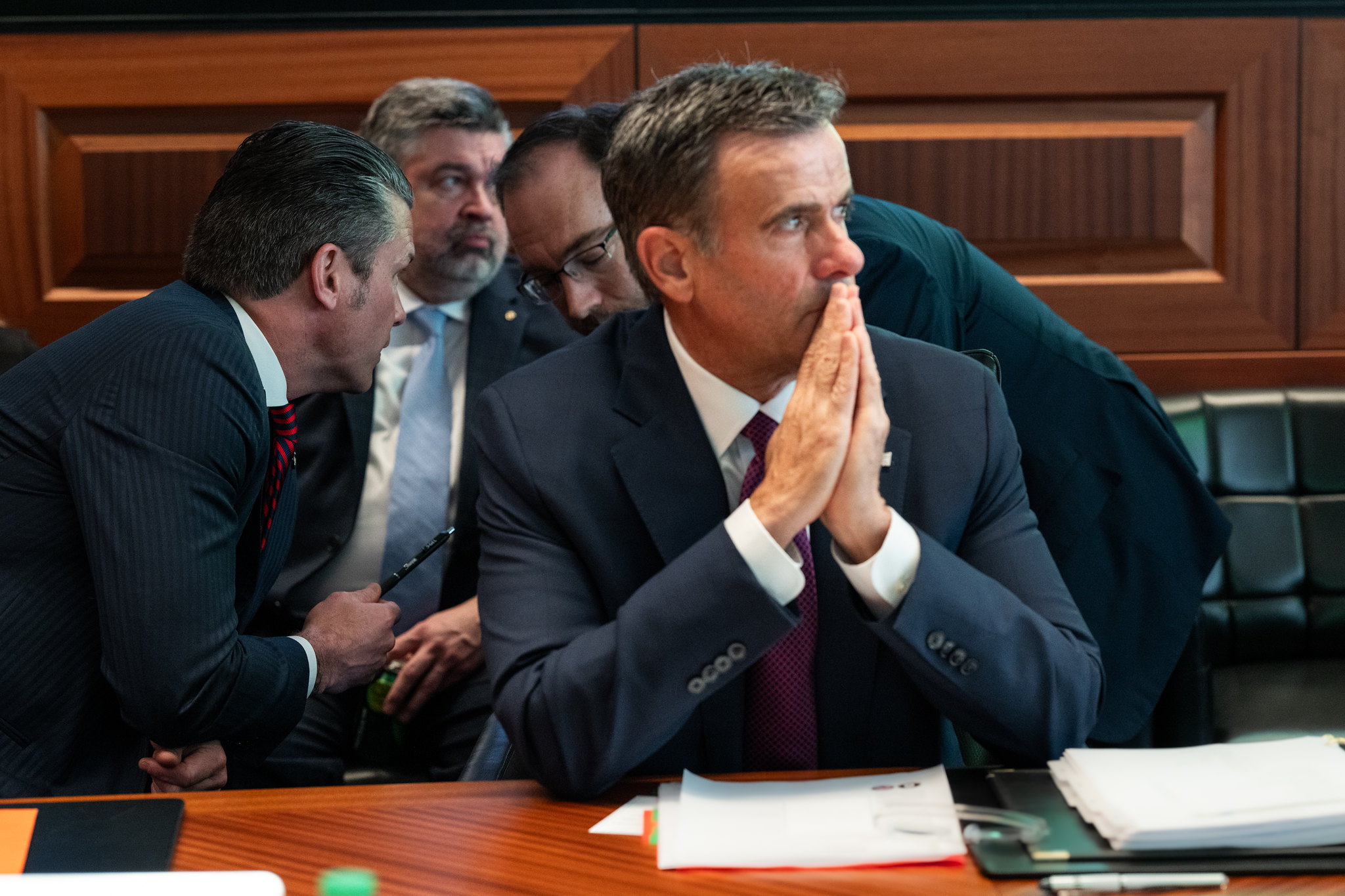The Situation: The Investigation Is the Point

Published by The Lawfare Institute
in Cooperation With

The Situation on Monday considered the case of former FBI Special Agent Michael Feinberg, a counterintelligence specialist, and how the FBI’s deputy director, Dan Bongino, forced him out for purely political reasons.
The following day, Fox News reported that:
Former CIA Director John Brennan and former FBI Director James Comey are under criminal investigation for potential wrongdoing related to the Trump–Russia probe, including allegedly making false statements to Congress, Justice Department sources told Fox News Digital.
CIA Director John Ratcliffe referred evidence of wrongdoing by Brennan to FBI Director Kash Patel for potential prosecution, DOJ sources told Fox News Digital.
The sources said that the referral was received and told Fox News Digital that a criminal investigation into Brennan was opened and is underway. DOJ sources declined to provide further details. It is unclear, at this point, if the investigation spans beyond his alleged false statements to Congress.
As for Comey, DOJ sources told Fox News Digital that an investigation into the former director is underway, but could not share details of what specifically is being probed.
A few days earlier, the CIA director—John Ratcliffe—had pulled a political stunt, releasing an internal “Tradecrafter Review” of the intelligence community’s 2016 assessment related to Russian interference in the presidential election.
I won’t rehash here everything that’s weird about this document, and Ratcliffe’s characterization of it. Earlier today, Lawfare published this excellent piece by Renée DiResta, which aptly summarizes the matter this way:
It focused particularly on one sentence: the ICA’s assessment that Russian President Vladimir Putin “aspired to help Donald Trump win.”
The review questioned whether the “high confidence” level for that conclusion was appropriate, ultimately finding that a “moderate” level would have been more appropriate. It also highlighted CIA objections to FBI leadership’s insistence on including the so-called Steele dossier in the ICA. The dossier had not met basic tradecraft standards and was viewed by senior CIA analysts as unverified and inappropriate for inclusion. Ultimately, it was appended as a two-page annex with a disclaimer stating it was not used to reach the analytic conclusions. However, the review noted that by referencing the annex in a supporting bullet for the “aspired” judgment, the ICA implicitly elevated unsubstantiated claims, thereby undermining the credibility of that key assessment.
Notably, however, the new review did not dispute the conclusion itself: That the Russians had favored the election of Donald Trump was not in question, nor was the judgment that they aspired to help. The Tradecraft Review was a process critique, not a substantive refutation.
Still, the release was immediately spun as exactly that. Ratcliffe gave an exclusive to the New York Post, which packaged a tradecraft audit that reassessed a confidence level as proof that the 2016 ICA was a “politically corrupted” hit job designed to “screw Trump.” It framed the audit as evidence that intelligence leaders had intentionally manipulated the ICA to damage Trump politically and to mislead the public about Russia’s true intentions. “All the world can now see the truth: Brennan, Clapper and Comey manipulated intelligence and silenced career professionals — all to get Trump,” Ratcliffe proclaimed as he promoted the article on X from the @CIADirector account.
Over at the Atlantic, Shane Harris offers similar conclusions and notes that triggering a criminal investigation—and the public announcement of one—may have been part of the purpose of ordering up the tradecraft review.
I could not be less interested in another round of picking at the scab of the 2016 election interference story. We know what happened: Russia interfered in the election in an effort to get Trump elected. We will never know whether it influenced the results in any meaningful sense. DiResta’s article details the many investigations that have affirmed this conclusion. That the Steele dossier turned out to be a dead end in no sense undermines these conclusions. Life is too short to spend more of it arguing with the hairsplitting of dilettantes and liars.
I do, however, want to make five specific points related to the Fox News story and the supposed criminal investigation of two former intelligence leaders.
First, note that the Fox News story is specifically sourced to “Justice Department sources.” This sort of sourcing in a story about an investigation is comparatively rare. This is not “sources familiar with the matter”—which is often code for defense lawyers—or “government investigators”—which is often code for congressional staff. This is a direct attribution of this story to the Justice Department. So is the following sentence, that the investigation follows a criminal referral from the CIA director. In other words, Fox News here is attributing to the Justice Department the fact that it received a criminal referral from the CIA related to the tradecraft review and opened a criminal investigation against Brennan and Comey in response.
Second, these events happened eight years ago. Indeed, Brennan and Comey have both been out of office for more than eight years. The normal statute of limitations for most relevant felonies, by contrast, is five years. So if the two conspired as government officials—as the Fox News article suggests—to do something nefarious to cook intelligence to get Trump, the statute of limitations for that offense, assuming such conduct even maps onto any known criminal offense, would have lapsed long ago. Ditto the statutes governing false statements and perjury. In other words, it’s completely unclear what the Justice Department—so eager to announce the investigation—might actually be investigating.
I can think of only two possible answers to this question.
Third, the first possibility is that some of the investigations of these matters dragged on for years, and some interviews might have taken place late enough that statutes of limitations have not yet run. For example, Comey gave one congressional testimony as late as September 2020, which would leave a few months yet before the statute of limitations on that. Brennan was interviewed by the John Durham investigation in August of the same year. So it’s theoretically possible that the investigation is limited to supposedly false statements made in the context of interviews made within the past five years.
Fourth, the second possibility—maybe more likely—is that the investigation is premised on a fanciful theory that the supposed “conspiracy” continued past the two men’s service in government. If you posit some conspiracy, after all, the statute of limitations runs five years past the end of the conspiracy, not five years after any of the specific acts that make up the conspiracy.
With respect to any supposed conspiracy involving Brennan and Comey to cook the intelligence on Russia to get Trump, we are operating in the land of fantasy. And when exactly does a conspiracy to commit a fantastical act end? In other words, if one predicates an investigation based on nonsense, it is possible to nonsense one’s way back quite a few years using a theory of conspiracy to nonsense.
Fifth, I actually doubt that either of these things is what is really happening here. What I think is happening is what one might call a ghost investigation.
When the CIA conducts a completely inexplicable tradecraft review over an eight-year-old document at the director’s specific insistence; when he then grossly mischaracterizes that investigation’s conclusion in announcing it in a fashion that literally anyone can detect merely by reading the underlying material; when the Justice Department then immediately discloses a criminal referral and declares that it has opened an investigation of the matter, notwithstanding presumably prohibitive statute of limitations issues; and when all of this relates to a matter, and two individuals, that happen to be a personal obsession of the president of United States, a certain skepticism is in order.
So let me be blunt: I don’t believe there is an investigation—not a real one, anyway.
There is an announcement of an investigation. There may be a paper investigation that gets closed quickly because there’s no evidence that anyone committed any sort of crime, the statute of limitations of which would have run anyway. There may be a decision not to close anything and to feed occasional further stories to Fox News or like-minded news outlets because having an investigation open—like opening it in the first place—is politically useful.
But an actual investigation? Come talk to me when a grand jury issues a subpoena or hears from a witness. Come talk to me when an actual agent is deployed to make an actual inquiry of someone.
Until then, I’m going to assume that the Fox News story announcing the investigation is the investigation—and that the Situation continues tomorrow.



.jpg?sfvrsn=2f856ee3_5)
